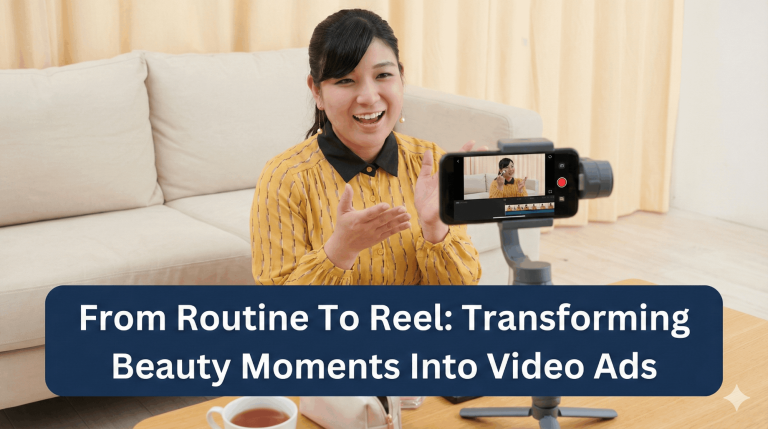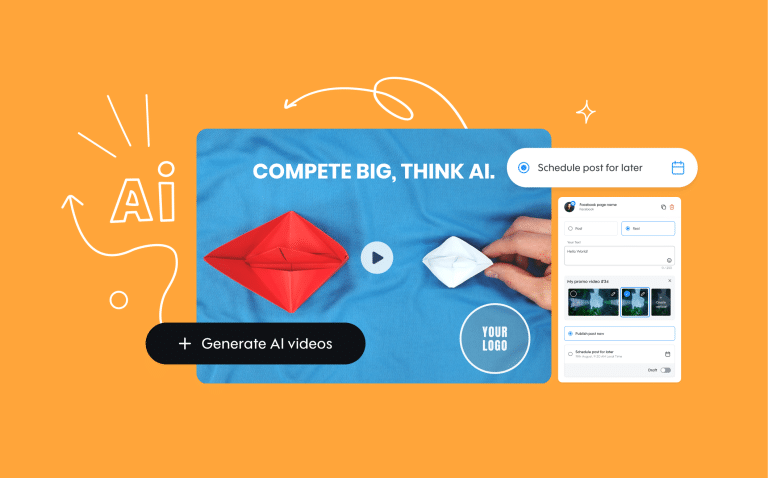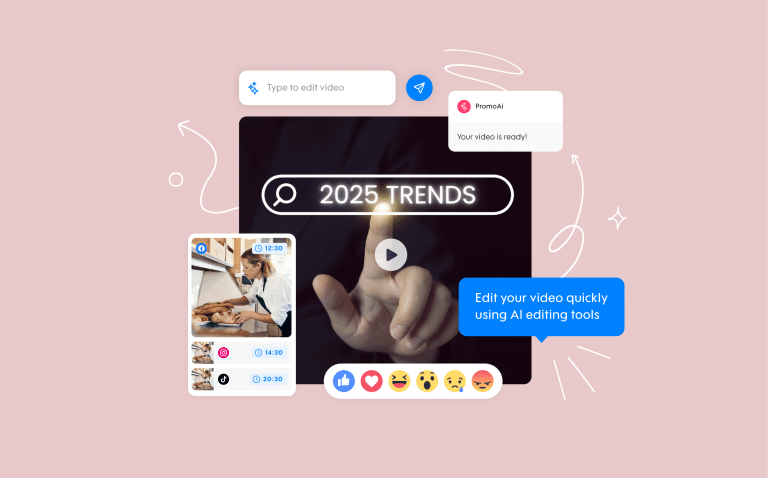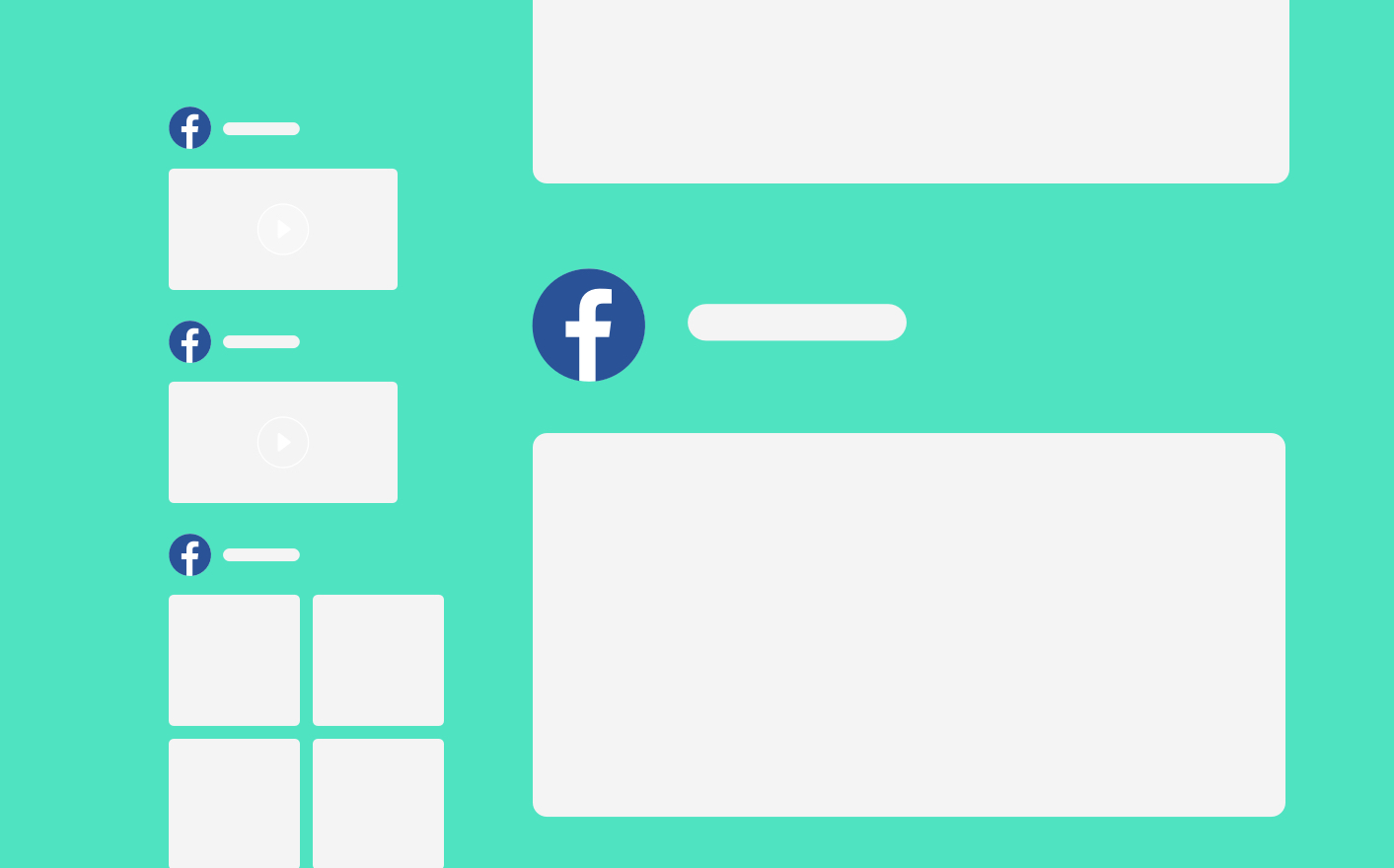
Facebook Advertising: The Complete Guide
In the social media age, if you aren’t advertising on Facebook, you’re falling behind. The good news is that promoting your business on Facebook is incredibly easy and you can get started in just a few minutes. However, the bad news is that like anything else, there’s a difference between “doing it” and “doing it well”.
But don’t worry. This is not your typical “good news / bad news” situation where the bad news is really bad and there’s nothing you can do about it. In this case, we’ve got you covered.
Being successful with Facebook advertising is your primary goal. Obviously, you’re not planning on simply throwing an ad out there and hope it works…wait, you weren’t, right?
In this article, we’ll cover everything you need to get started with Facebook advertising, from choosing the right type of ad to managing and analyzing campaigns. There’s a reason we called this “a complete guide!
So strap in, grab a cup of coffee, and be prepared to take notes. There’ll be a test later.
Just kidding. Let’s get started!
Why advertise on Facebook?
If you’re reading this, you probably have a pretty good idea of why Facebook advertising is a good idea for your business. But just in case you need a little extra convincing, consider the following:
- 80% of all internet users are using Facebook. That’s kind of a lot of people. When customers ask “which social media network should I be focusing on?” The answer is almost always “start with Facebook.” The key is knowing what platform your customers are on and how best to reach them, but with 80% of all internet users on Facebook; when in doubt, assume you can find them there.
- Social Media is one of the least expensive forms of advertising available and Facebook might have the best return of any platform. This is due, in part, to the awesome targeting capabilities of Facebook’s Ad Manager. Don’t worry, we’ll get to more on that in a little bit.
- Facebook advertising also stands out from other forms of online (and offline) advertising in that there are few, if any, hidden or extra costs. For example, if you’re planning on sending coupons by direct mail, there are a LOT of costs to consider. You have to print the coupon, pay someone to stuff envelopes, pay for those envelopes, etc. Oh, and let’s not forget about paying for stamps! Social media ads allow you to set your exact budget and stay within it. Check out this article about the cost of advertising on Facebook to learn more about ad auctions and bidding strategy.
Need we say more? Alright, let’s dive into the good stuff then.
Choosing a Goal (Facebook Ad Objectives)
Facebook’s Ad Manager prompts you to select an “Ad Objective” for every Ad Campaign you create, where you can choose one of 13 different campaign goals:
Video Views
To get people to watch your amazing videos. Really inexpensive when compared to other objectives, and when used together with a good creative, it can drive a lot of qualified traffic, since your leads will be better informed about your product.
Reach
The reach objective is going to try to expose your ad to as many people in the targeted audience as possible. The goal of this objective is to try to maximize exposure, period.
Traffic
Most useful if your goal is to send traffic to your website or app install page. Good for when you have a long sales funnel/buyer journey (when you don’t expect to convert prospects on the first interaction).
Engagement
Increase your page or post likes, shares, etc. Can be a good way to build some social proof or use it as a remarketing tool.
Lead Generation
The best option when you have to sell something – if you use it together with the right content, can be directed towards all funnel stages.
Conversions
Get people to take a specific action on your website such as making a purchase, subscribing to a list, etc. Incredibly powerful, but needs to target the correct funnel stage (don’t use it to target top of the funnel audiences, since they are still not ready to convert at this stage).
Brand Awareness
The Brand Awareness objective is geared toward introducing your brand to the untapped, awaiting masses! (think about “ad recall”).
Messenger
Great for engagement, since it encourages people to contact you by using Facebook Messenger.
Page Likes
Very straightforward, to generate more likes to your Facebook Page.
Event Response
For promoting an event (one that has a Facebook Page and Event) and drive attendance to it.
Store Traffic
For those of us who have a physical storefront, this objective will drive local awareness for one or multiple brick-and-mortar locations.
Catalog Sales
To be used by eCommerce owners that have a catalog of products connected to their Facebook Business Manager.
App Install
To get more people to install your app.
Choose your objective wisely and make sure it aligns with what you’re really trying to accomplish.
The sky’s the limit so start flying.
Targeting your audience
You’ve got questions about Facebook advertising and we have the answers! But here’s one important question that you should answer on your own: who’s your target audience?
Every successful business, up to and including the most successful brands you can think of, spends extensive resources in order to answer this question.
Somewhere in the headquarters of Starbucks, Coca-Cola, and Apple, there are elaborate customer profiles, mapped out in intricate detail to understand who the target customer of that company (or campaign) is. And we mean, precisely.
This includes their values, habits, interests, age, income, location, etc. They even create fake names to bring them to life and you should too. Hey, if it’s good enough for Starbucks, it’s good enough for us, right?
Take the time to figure out who your customer is. Only then can you go after them with Facebook’s ad targeting feature. If your ideal customer is a 30-year-old woman from Illinois who drinks coffee and likes frozen yogurt, you can target them, through what Facebook calls “Custom Audiences”.
But, unless you have a women-only coffee-flavored frozen yogurt shop in Illinois, this might be too specific. You can target your customers based on a number of broader qualifiers (targeting options), such as:
- Age
- Gender
- Geographic location
- Interests
- Purchasing Behavior
- And more.
Setting a budget
Running advertisements on Facebook comes with a cost (of course). But it’s not the same as placing an ad in the paper or running a radio commercial. For one thing, advertising on Facebook is a lot less expensive! For another, you get to set your own budget (use our Facebook Ad Budget Calculator to know what should be your budget by answering a few simple questions.) This is a great boon to the small or mid-sized business which may not have the bottomless pockets that some of the big boys have.
There are two basic ways to set your ad budget on Facebook.
- Per ad set (one ad)
- Per ad campaign (a number of ads in a larger campaign)
In addition, you also have the option to set a daily or lifetime budget. A daily budget determines how much you will spend every day. You can set an end date for your campaign or have it run until you decide to stop it. A lifetime budget determines how much you will spend over a period of time that you set beforehand. For instance, you can spend $10 a day over 10 days or you can spend $100 over a set period of time.
There are plenty of options to choose from. Obviously, the higher your budget, the more successful your campaign is likely to be. However, that doesn’t mean a big budget means guaranteed success.
Your next mission, should you choose to accept it (and you should), is to measure your ad’s performance.
What are the different types of Facebook ads?
The many different types of Facebook ads include photo ads, video ads, carousel ads, story ads, and more. We will go into detail about each ad type below.
Photo ads
Standard, straightforward. These are the basic ads you see on Facebook that feature an image, a short bit of copy, and a call-to-action which usually drives you to like a page or visit a website. Here’s a simple photo ad from Starbucks. The purpose of this ad is to prompt people to download the Starbucks mobile app. 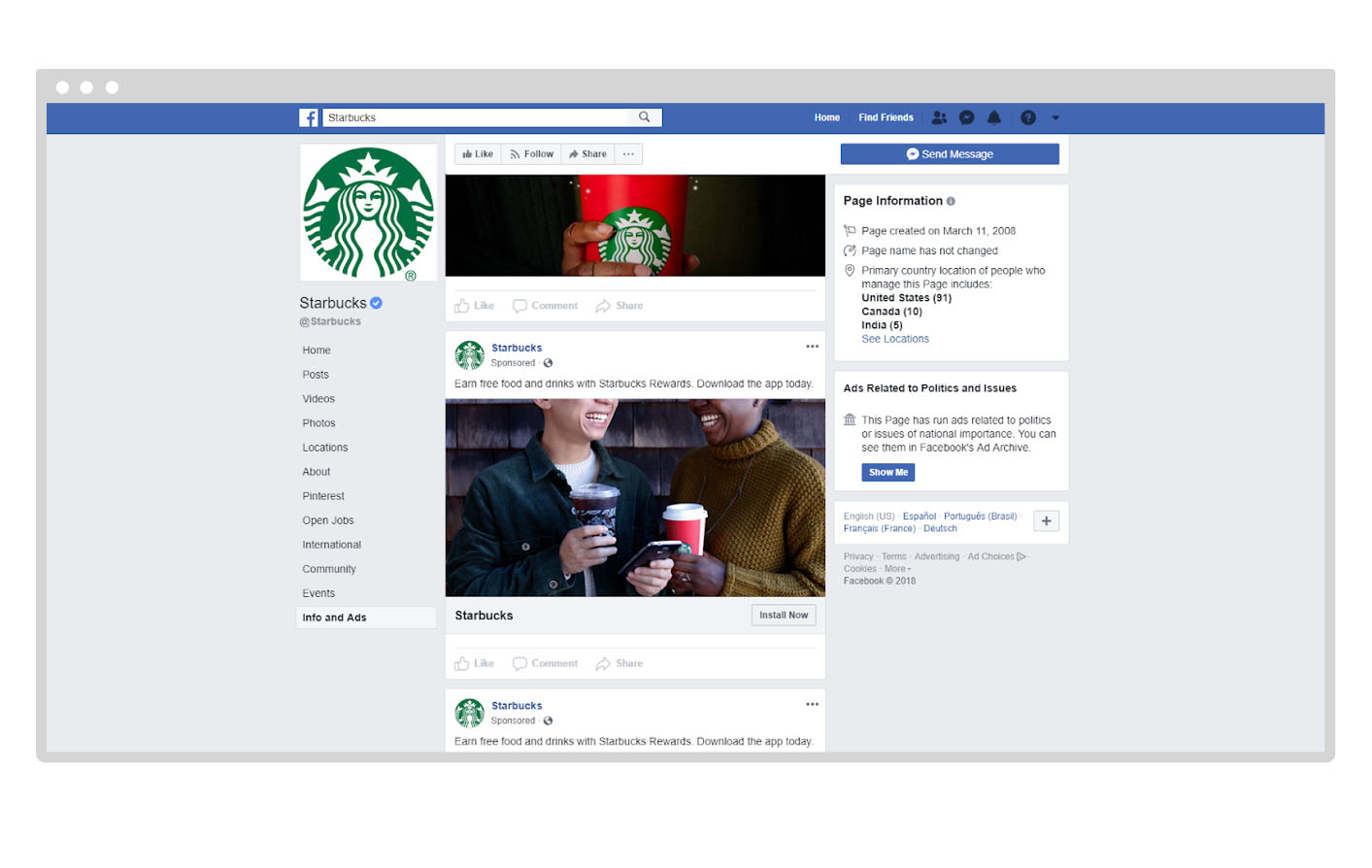 The “Install Now” prompt at the bottom right is the call-to-action, or “CTA.” Remember that term as we’ll come back to it often. Already know what a CTA is? You’re ahead of the game!
The “Install Now” prompt at the bottom right is the call-to-action, or “CTA.” Remember that term as we’ll come back to it often. Already know what a CTA is? You’re ahead of the game!
Best practices
Select an ad that speaks to your brand. Happy people enjoying your product (see example above) is always a good idea. Think positive and upbeat. Your ideal image size is 1200 pixels wide, and no smaller than 600. To perfectly size your image for Facebook, check out our Free Image Resizer!
Pros and cons
Image ads are by far the easiest ad to get started with. Creating an image suitable for Facebook advertising can be accomplished with freelancers, outside contractors or even on your own if you’re feeling creative.
The downside is that Facebook image ads aren’t ideal for every purpose such as showing a product in action or grabbing an audience’s attention. There’s also a TON of them out there to compete with. Most are not as eye-catching and impactful as we’d like to believe they are. A picture can tell 1,000 words but it doesn’t always leap off the page the way a moving image can.
Video Ads
Facebook video ads are the new big thing on Facebook. Well, not so “new,” but they are increasing in use and popularity. In fact, it’s been projected that by 2021, over 80% of all internet traffic will be video content. Add to that, more video content is uploaded to the internet in 30 days than all major US television networks have created in 30 years. Combined.
Wow.
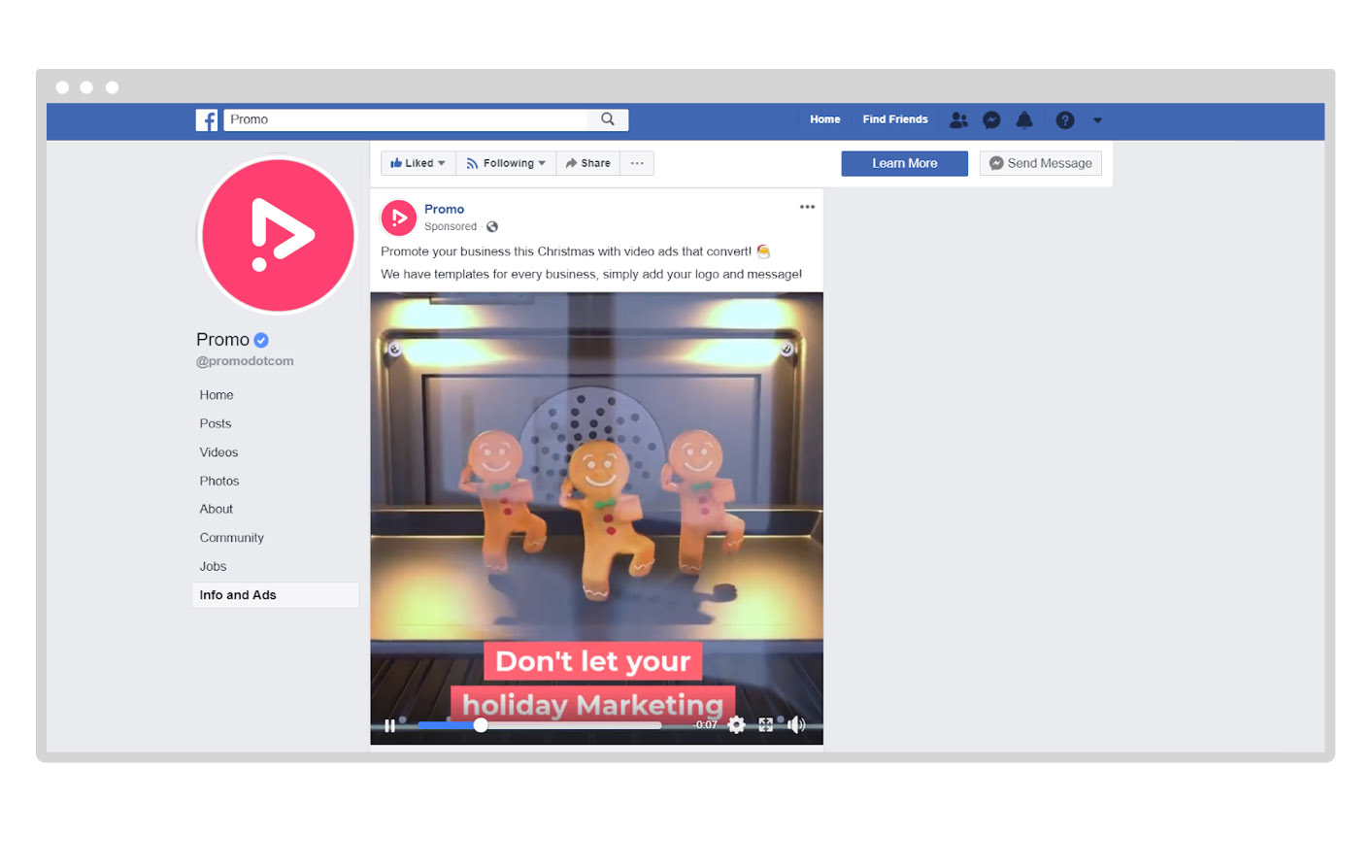 Video ads allow you to showcase your product or service in action. The above video ad shows one of Promo’s popular holiday video ads in action. After all, we could simply tell you that we have videos that show gingerbread men dancing a Gangnam Style dance… but isn’t it more impactful to show it?
Video ads allow you to showcase your product or service in action. The above video ad shows one of Promo’s popular holiday video ads in action. After all, we could simply tell you that we have videos that show gingerbread men dancing a Gangnam Style dance… but isn’t it more impactful to show it?
Best practices
Don’t skimp on quality. It’s true that these days everyone has a video camera in their pocket but that’s not the best way to create a branded video ad for your business. Thankfully, creating professional quality video ads is easier and more cost-effective than ever before. With platforms like Promo.com, you can create awesome videos that catch your audience’s attention. Your ideal length is between 5-15 seconds. For a professional video, this is more than enough time to hook ‘em, draw ‘em in, and hit them with the call to action.
Technically, your video’s aspect ratio should be between 9:16 and 16:9 with a 1080p resolution. Include subtitles in your video for the roughly 85% of Facebook videos which are watched without sound (so THAT’S what everyone is doing at their desk instead of working!).
Many watch Facebook videos without sound so if you’re including narration, make sure to include accompanying subtitles. However, if your video isn’t narrated, just make sure to include relevant text which supports the content of the video. In short, don’t rely solely rely on the sound to sell your message.
Pros and cons
Video ads are one of the fastest growing and most effective (from an ROI standpoint) form of Facebook advertising. Professional quality video ads elevate your business from a branding standpoint and help you set yourself apart as an organized, professional business.
Video ads do take some time to create; however, tools such as Promo.com have cut that time down considerably. There’s a larger investment in time when managing video ads and you will likely need to test frequently to ensure you’re making the most of them. In short, Facebook Video Advertising is not a sure thing, but it will put you in the best position to be successful.
For some true ad inspiration as you’re brainstorming your Facebook video ads, check out these best Facebook video ad examples. You’ll see an array of captivating video ads, learn why they work so well, and what practices you can adopt to ensure your own are high performing.
Carousel ads
Why not have the best of both worlds, right? Carousel ads allow you to do just that. By combining a series of photos and/or videos together into, well, a rotating carousel. This is helpful for showing off a process such as step-by-step instructions; or for promoting an entire line of products in a single ad.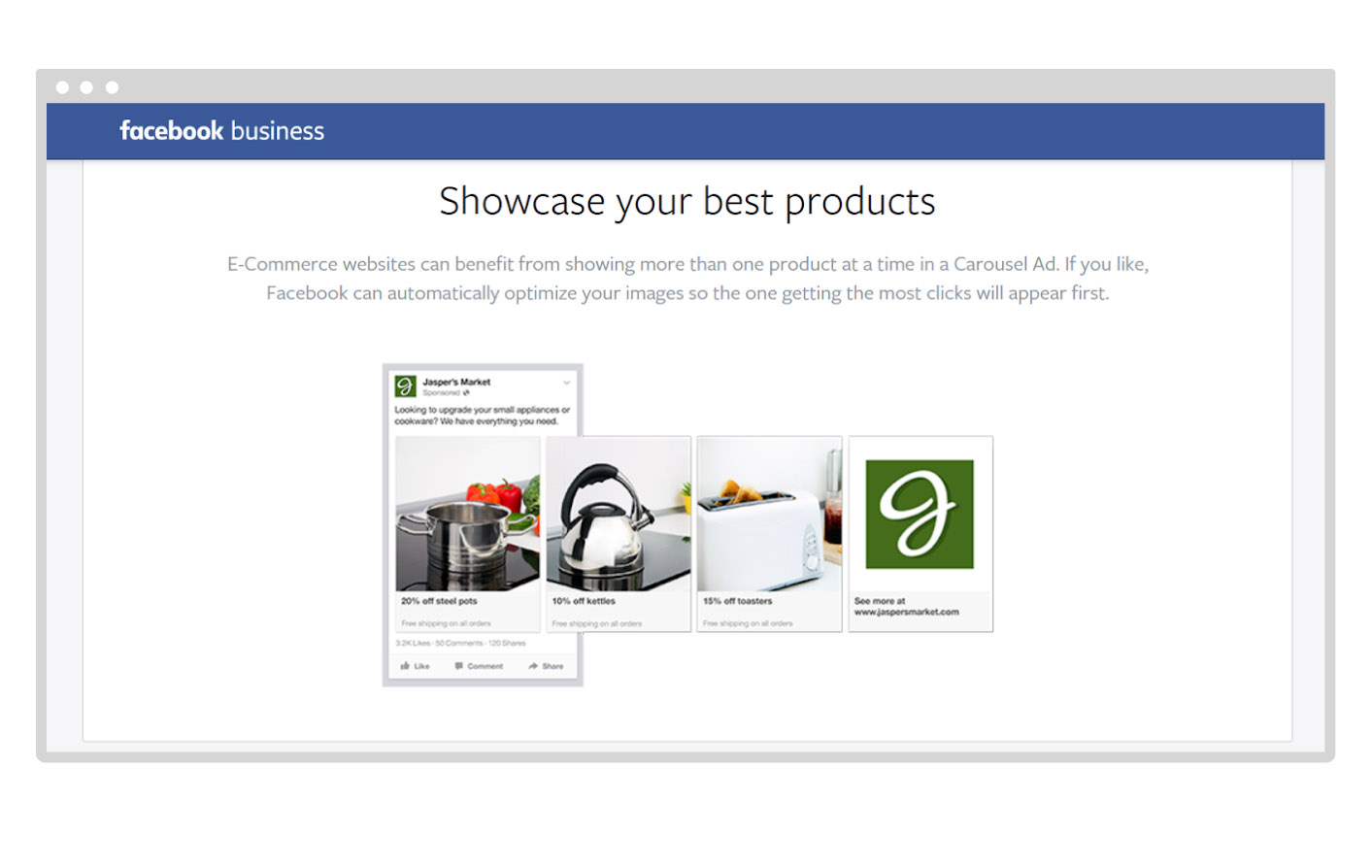
Best practices
Select videos and images which tell your story and follow a logical progression. Consider the carousel above. These products all fall into the same general category of small appliances and cookware. This set is promoting a specific product line. When possible, use the same type of content to keep the imagery consistent throughout.
Pros and cons
Carousel ads are ideally suited for showing off a progression (such as the steps necessary to take for a product or service); or showcasing a product line with multiple products. However, they’re not ideal for every campaign focus. In addition, it can also be time-consuming to create a carousel which meshes will. Taking additional photographs or videos to have them line up with one another (as above) can be an extra step that some folks may not want to deal with.
Stories ads
No, we are not mistaking Facebook for Instagram. Facebook Stories is a relatively new, but popular feature. What’s more, you can advertise on it as well. Over 300 million people engage with Facebook stories every day. Should your business be one of them? 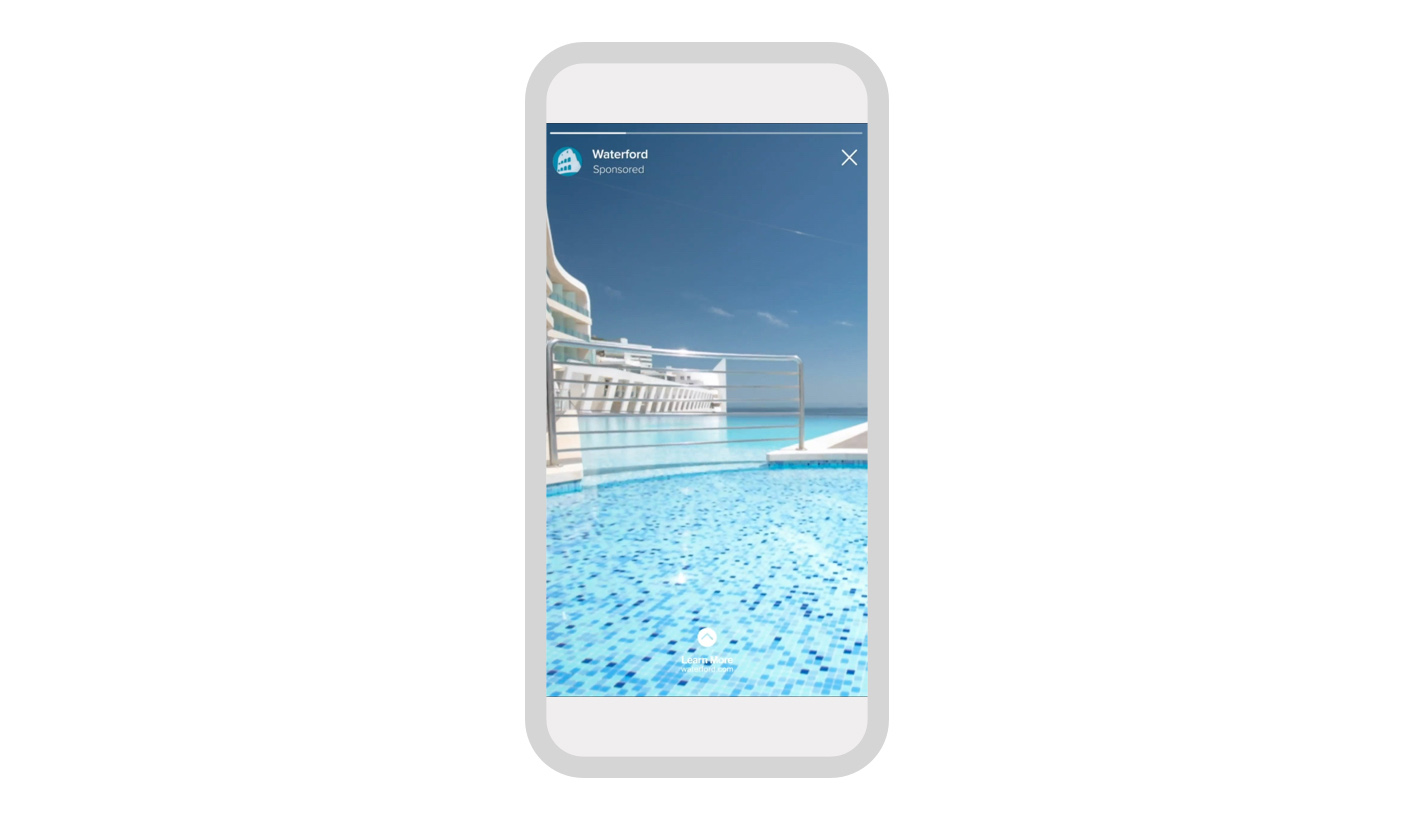 Facebook Stories’ ads function similarly to the way Instagram Stories ads function. That is in the form of sponsored video or photo content shown to the user while browsing other users’ stories. With over 300 million users daily users, Facebook Stories ads are becoming a great way to capture people when they’re browsing one of the more up and coming features of Facebook.
Facebook Stories’ ads function similarly to the way Instagram Stories ads function. That is in the form of sponsored video or photo content shown to the user while browsing other users’ stories. With over 300 million users daily users, Facebook Stories ads are becoming a great way to capture people when they’re browsing one of the more up and coming features of Facebook.
Best practices
Ensure that your video is created for mobile consumption as Stories (both Instagram and Facebook). Max image size should be 500x500px with an aspect ratio of 1:91 to 9:16. Your video ad can be between 1-15 seconds. Use clear imagery, convey your information quickly, and send users on their way with a strong call-to-action.
Pros and cons
Instagram Stories ads have been around for a while now and have a well-established foothold in the video ad market. Facebook stories are relatively new by comparison and they have yet to gain the traction of their Instagram brethren. As such, there may be a learning curve involved.
Pro tip: Stories ads are ideal for quick hits of information rather than lengthy pitches. Keep it simple and don’t use this space to get wordy. Like a cat burglar: get in and get out.
Facebook Messenger Ads
If the right people aren’t coming to you, you may as well go to them! Facebook messenger ads function much the same way as other ad types, yet the ads are delivered straight to Facebook users while they are using the Facebook messenger app.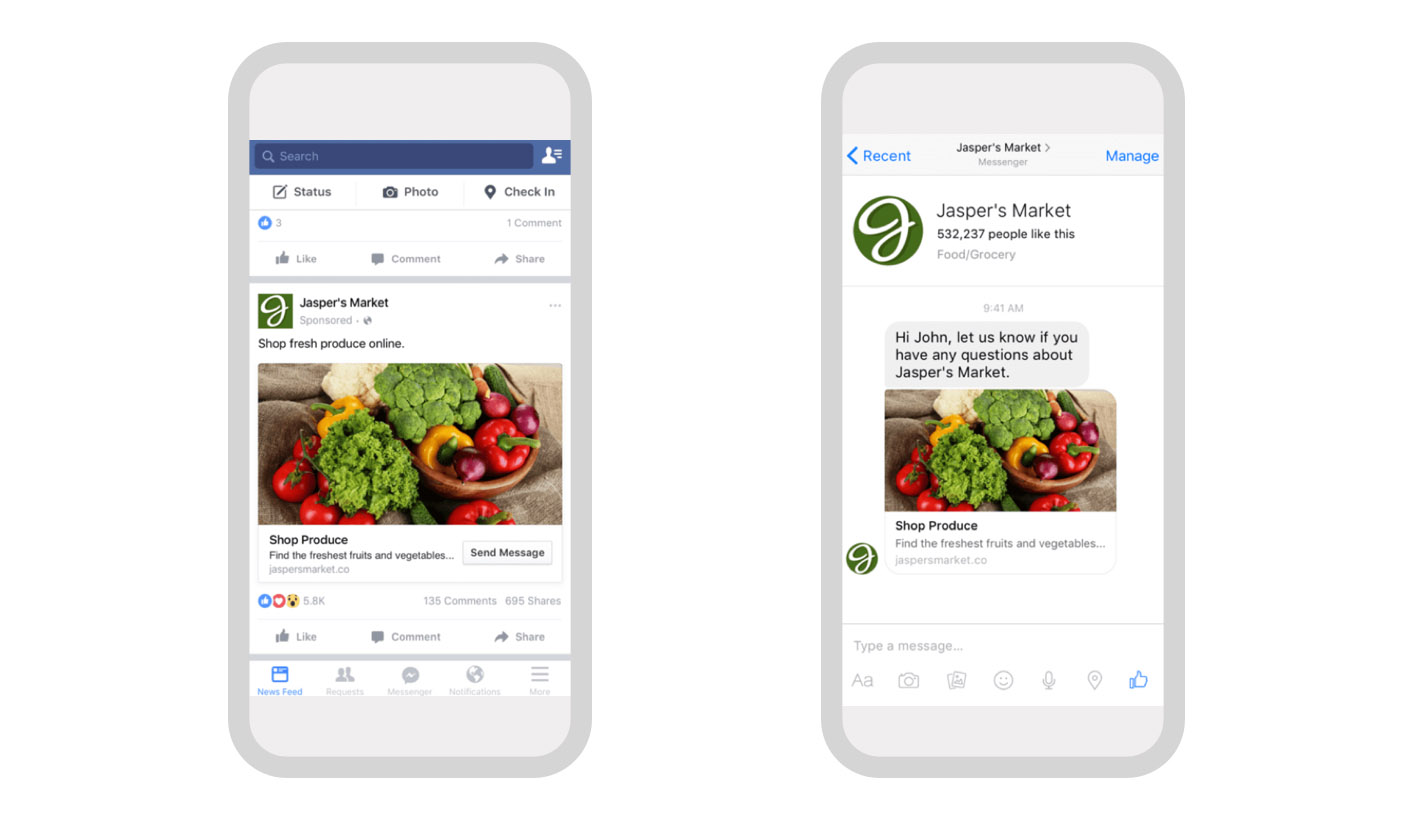 This allows you to access an additional 1.3 billion people who use Facebook messenger monthly.
This allows you to access an additional 1.3 billion people who use Facebook messenger monthly.
Best practices
Ensure that your video is created for mobile consumption as the vast majority of Messenger users are on mobile devices. Also, be aware of the specific technical requirements of messenger ads. Facebook also allows you to use other ad sets for your messenger campaigns. You may also use the “automatic placements” feature. These are designed to deliver ad impressions to the placement which is most likely to drive results at the lowest possible cost. If you choose to edit placements, you can include Messenger as long as Facebook Feed is also selected.
Pros and cons
Facebook messenger ads are a great way to reach your audience but on the other hand, you are somewhat limited in terms of the technical requirements. Additionally, some users may find the presence of ads in their messages invasive.
Other ad types
While there are many types of Facebook ads, the above four are the primary types that most people focus on. Other ad types include:
- Slideshow ads: Using photos and short videos to create a dynamic ad (similar to a gif).
- Lead ads: Mobile-only ads that allow for easy capture of email addresses or other signups. Great for building a list.
Another great Facebook feature that can be used in advertising is a Facebook Video Poll, where you can add a poll to any of your Facebook videos to collect user opinions (read more about Facebook Video Polls here).
For a more detailed look into the best practices that cover all of the above Facebook ad types, check out our post on this topic . We’ll take you from start to finish to help you strategize, plan, and surpass even your own expectations.
Defining and measuring success
Remember how we said that advertising on Facebook wasn’t something you “just did?” Well, that’s where the measuring success part comes into play! This ain’t no “set it and forget it” procedure here.
There are a number of factors that contribute to the success or failure of your Facebook ad campaigns. Among them:
- Your creative (video)
- Your budget size
- The audience and location(s) you are targeting
- The creative ad copy
Defining success with your Facebook advertising will come down to your intended goals. Converting sales? Expanding your reach and building your Facebook page audience? Your end goal will determine your definition of success.
This is why it’s important to set clear goals for your ad campaigns. The real talk? You can have an ad campaign which generates a TON of engagement (likes, shares, etc) but isn’t successful. How? Well, if you haven’t set a goal for you to reach, you won’t know if you got there!
Consider an ad that has generated 5,000 views, 10 new page likes, and 10 shares. Successful? Hard to say. What were you going for? 100 new page likes? If so, then the ad was not a success.
Be careful of so-called “vanity metrics.” These are stats which are great to have but often don’t tell the whole story. Knowing that your ad has been seen 5,000 times is great and no one can objectively say that’s a “bad thing.” However, you aren’t (and shouldn’t) looking for views as much as you’re looking for what comes next. If your goal is to create tangible actions (such as likes, shares, website visits, sales, etc) then views are nice but aren’t accomplishing your goal.
Look at it from a different perspective. Would you rather have 1,000 new visits to your website and 0 sales; or 100 new visits to your website and 1 new sale? It’s not a trick question. The sale is the ultimate goal of any marketing effort. Hence, you’d rather have the 100 visits and the 1 sale than any number of visitors who aren’t buying.
Since the introduction of the Facebook Ad Library, businesses have been able to analyze ads from other businesses to help them measure success. This is a great way to approach Facebook ads to emulate success and learn what works versus what doesn’t.
Testing for success
We can try to (badly) force that headline to rhyme, but we can’t force your ad to be successful. For that, you have to test, adapt, and test some more. Piggybacking on our attempt to define success, it’s important to ensure that you’re measuring properly as well.
For this, you’ll want to look at the costs involved in achieving your desired results. This information can be found in your ads manager and tell a more complete story of your campaign’s results than raw data can.
Your “cost per result” will reveal how much you’re paying (of your budget) that is generating the intended purpose. So, for example, if your ad budget is $100 and your goal is to increase your page likes; 1 new page like will have an associated cost of $100.
Yikes, that’s not good! Thankfully, if you were to generate 2 new page likes, your cost per result is cut in half to $50 and so on and so on. The good news? You aren’t likely to only generate a couple new likes with a good ad and a $100 budget.
In order to get the most out of your campaigns, you’ll need to start split testing.
Split Testing
Split testing (or A/B testing) is when you run two similar ads at the same time. Each ad will have identical goals but will differ in a small way. It might be a different call to action, a different language in your written copy, or a different image or video.
The goal is to run these ads at the same time, and with the same goal, and see which one performs better. You’d be amazed at how much of an impact even a slight change of wording can have on an ad’s performance.
When comparing ads, you’ll want to set the same focus and budget for each. Other than that, feel free to be creative. Try a different video for each ad, re-work the wording of your CTA. Here’s one thing we know: one is going to perform better than the other.
Once you’ve determined which ad is performing better, your work is not done! Rather, now try and create an even BETTER ad to beat that one! This may seem like a lot of work, but it really isn’t. Facebook allows you to upload new ads with ease. Creating ads, from images to video, is also easier and more affordable than it’s ever been before!
Imagine just a few short years ago. If you were creating a video ad, there were very few options available to you. You had to hire a team to produce your video which cost thousands of dollars. even, your options for showing the video were limited. Purchasing ad time on a television network was and still is extremely expensive.
With Facebook, not only are your advertising costs reduced dramatically; you can also create new content and upload it with ease. In 1980, once you created your advertisement, you had to cross your fingers and hope it worked!
Good news! The award-winning creative department and user acquisition team at Promo.com put their heads together to uncover the secret formula behind effective Facebook video ads and turned it into a workbook just for you: Click here to download our Facebook Video Advertising eBook!
How do beginners advertise on Facebook?
If you are wondering how to create your first Facebook ad, it’s not as complicated as you might think. Craft your marketing strategy and take some time to review the terms we covered. Once you’re familiar with the terminology and the flow of the Facebook Ads Manager, you can confidently get started.
To create your first Facebook ad you will need to:
- Sign in to the Facebook Ads Manager
- Identify your goal
- Choose your objective
- Select your target audience
- Choose your ad placement – where you want your ad displayed
- Select your budget
- Choose your ad format
Now you’re armed with all the information you need to begin planning, creating, and posting successful Facebook ads. For a detailed step-by-step with screenshots that guide you through the Facebook Ads Manager, check out our article on exactly how to create your first Facebook ad.
Ready to get going?
Whew! You made it! If you’re still with us, you now have a great foundation to start your Facebook advertising journey. Even if you skipped around to the good parts (we won’t judge), you still know everything you need to get started. As promised, we won’t test you. However, if we DID; you should be able to pass!
Facebook advertising presents an excellent opportunity for your business to reach your ideal customers on the world’s most popular social media platform. By conquering the Facebook ad world, you’re ready to be successful!
[banner id=11501]
